Analysis of Factors Impacting Chinese FDI in Africa: A Research Report
VerifiedAdded on 2023/01/05
|49
|11738
|91
Report
AI Summary
This report delves into the factors influencing Chinese Foreign Direct Investment (FDI) in Africa. It begins with an introduction outlining the background, significance, objectives, and structure of the research, followed by a literature review exploring theoretical and empirical aspects of FDI's impact on economic growth, particularly in Africa. The report then provides an overview of the African economy, including its performance and trade dynamics. The methodology section details the data, area, scope, model specification, and analysis methods used. The core of the report presents empirical analysis and results, followed by conclusions, recommendations, and discussions of limitations and future research directions. Key areas of focus include the reasons behind Chinese investment in Africa, the impact of FDI on economic and employment growth, and the role of companies like Huawei in this context. The report also addresses research questions regarding the definition of FDI, the factors influencing Chinese investment, related issues, and potential strategies to mitigate negative impacts.
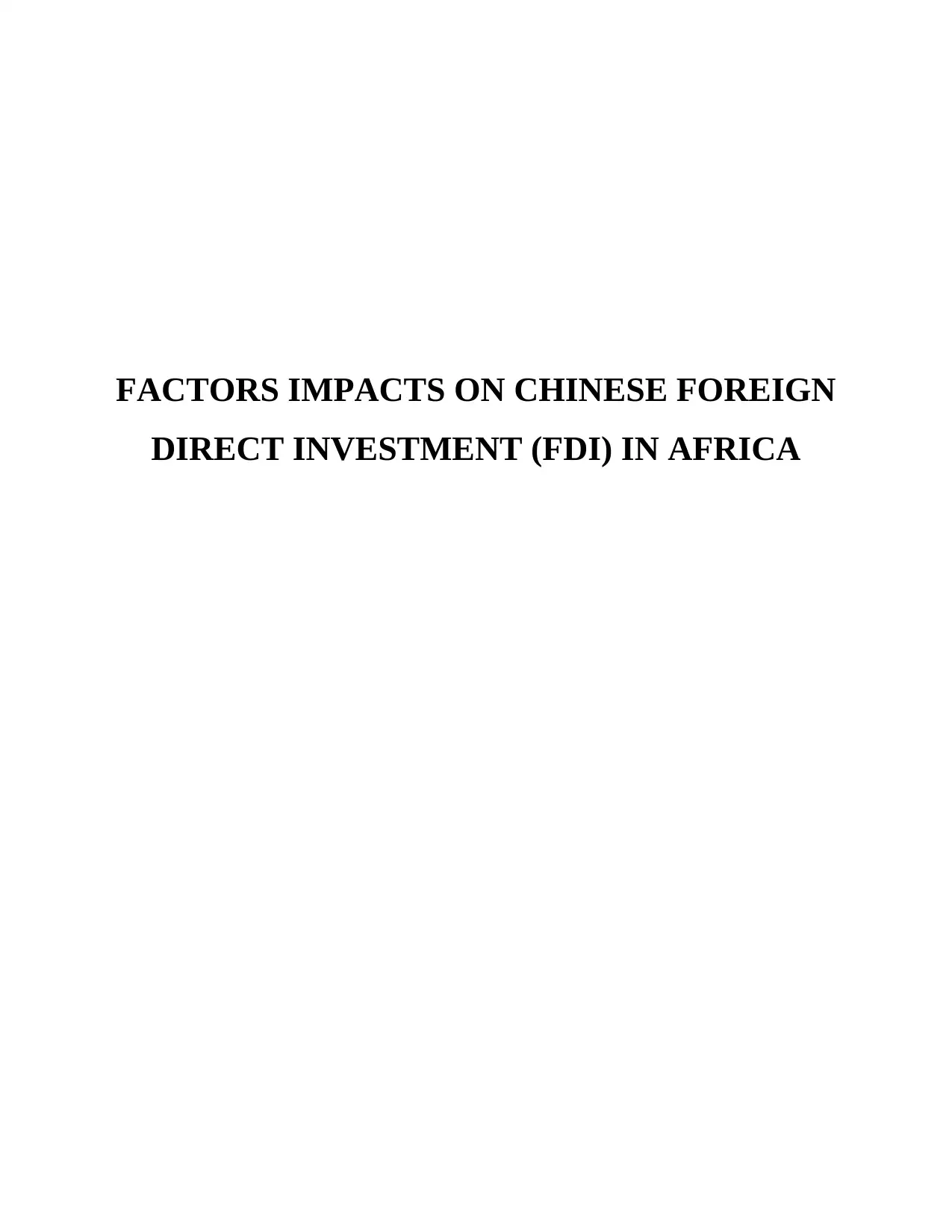
FACTORS IMPACTS ON CHINESE FOREIGN
DIRECT INVESTMENT (FDI) IN AFRICA
DIRECT INVESTMENT (FDI) IN AFRICA
Paraphrase This Document
Need a fresh take? Get an instant paraphrase of this document with our AI Paraphraser
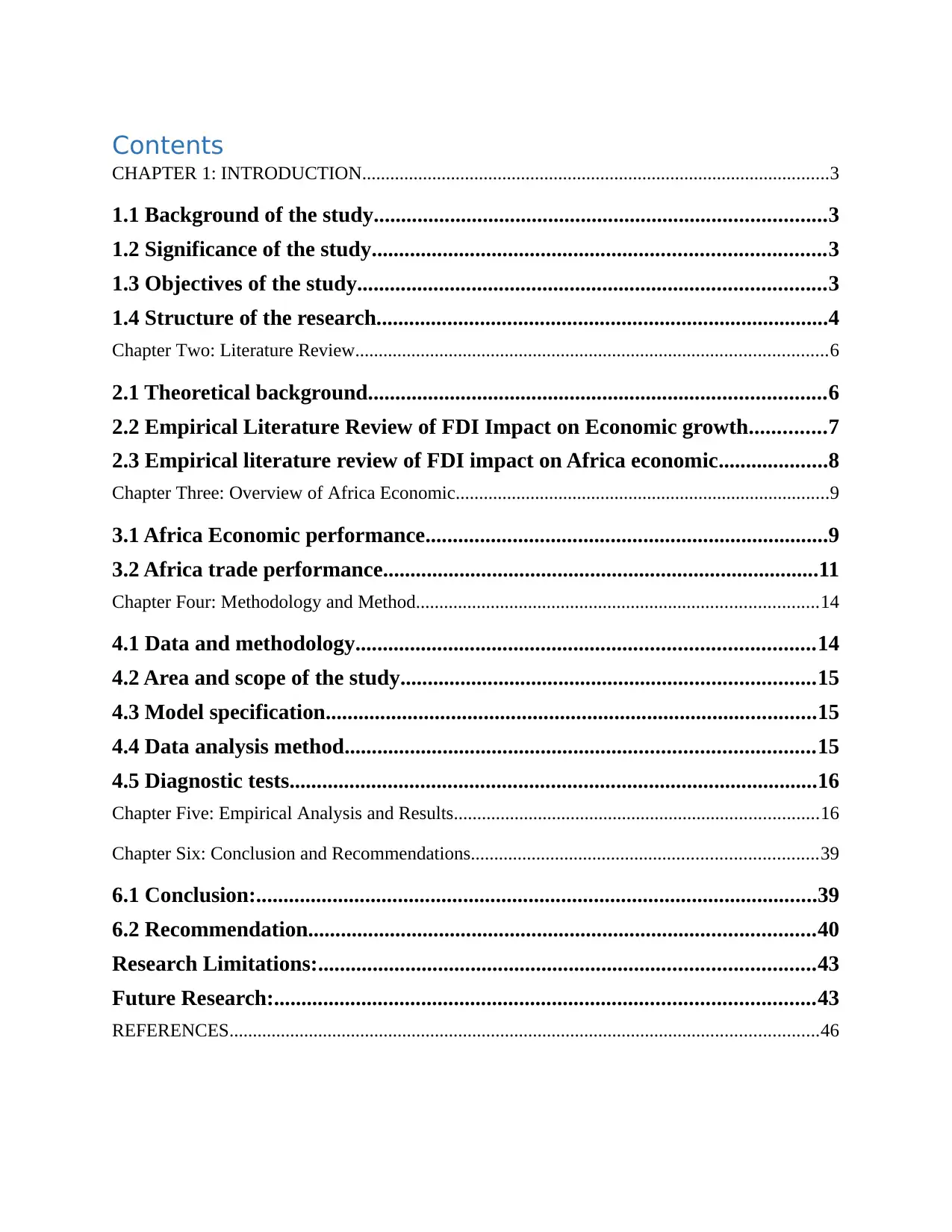
Contents
CHAPTER 1: INTRODUCTION....................................................................................................3
1.1 Background of the study...................................................................................3
1.2 Significance of the study...................................................................................3
1.3 Objectives of the study......................................................................................3
1.4 Structure of the research...................................................................................4
Chapter Two: Literature Review.....................................................................................................6
2.1 Theoretical background....................................................................................6
2.2 Empirical Literature Review of FDI Impact on Economic growth..............7
2.3 Empirical literature review of FDI impact on Africa economic....................8
Chapter Three: Overview of Africa Economic................................................................................9
3.1 Africa Economic performance..........................................................................9
3.2 Africa trade performance................................................................................11
Chapter Four: Methodology and Method......................................................................................14
4.1 Data and methodology....................................................................................14
4.2 Area and scope of the study............................................................................15
4.3 Model specification..........................................................................................15
4.4 Data analysis method......................................................................................15
4.5 Diagnostic tests.................................................................................................16
Chapter Five: Empirical Analysis and Results..............................................................................16
Chapter Six: Conclusion and Recommendations..........................................................................39
6.1 Conclusion:.......................................................................................................39
6.2 Recommendation.............................................................................................40
Research Limitations:...........................................................................................43
Future Research:...................................................................................................43
REFERENCES..............................................................................................................................46
CHAPTER 1: INTRODUCTION....................................................................................................3
1.1 Background of the study...................................................................................3
1.2 Significance of the study...................................................................................3
1.3 Objectives of the study......................................................................................3
1.4 Structure of the research...................................................................................4
Chapter Two: Literature Review.....................................................................................................6
2.1 Theoretical background....................................................................................6
2.2 Empirical Literature Review of FDI Impact on Economic growth..............7
2.3 Empirical literature review of FDI impact on Africa economic....................8
Chapter Three: Overview of Africa Economic................................................................................9
3.1 Africa Economic performance..........................................................................9
3.2 Africa trade performance................................................................................11
Chapter Four: Methodology and Method......................................................................................14
4.1 Data and methodology....................................................................................14
4.2 Area and scope of the study............................................................................15
4.3 Model specification..........................................................................................15
4.4 Data analysis method......................................................................................15
4.5 Diagnostic tests.................................................................................................16
Chapter Five: Empirical Analysis and Results..............................................................................16
Chapter Six: Conclusion and Recommendations..........................................................................39
6.1 Conclusion:.......................................................................................................39
6.2 Recommendation.............................................................................................40
Research Limitations:...........................................................................................43
Future Research:...................................................................................................43
REFERENCES..............................................................................................................................46
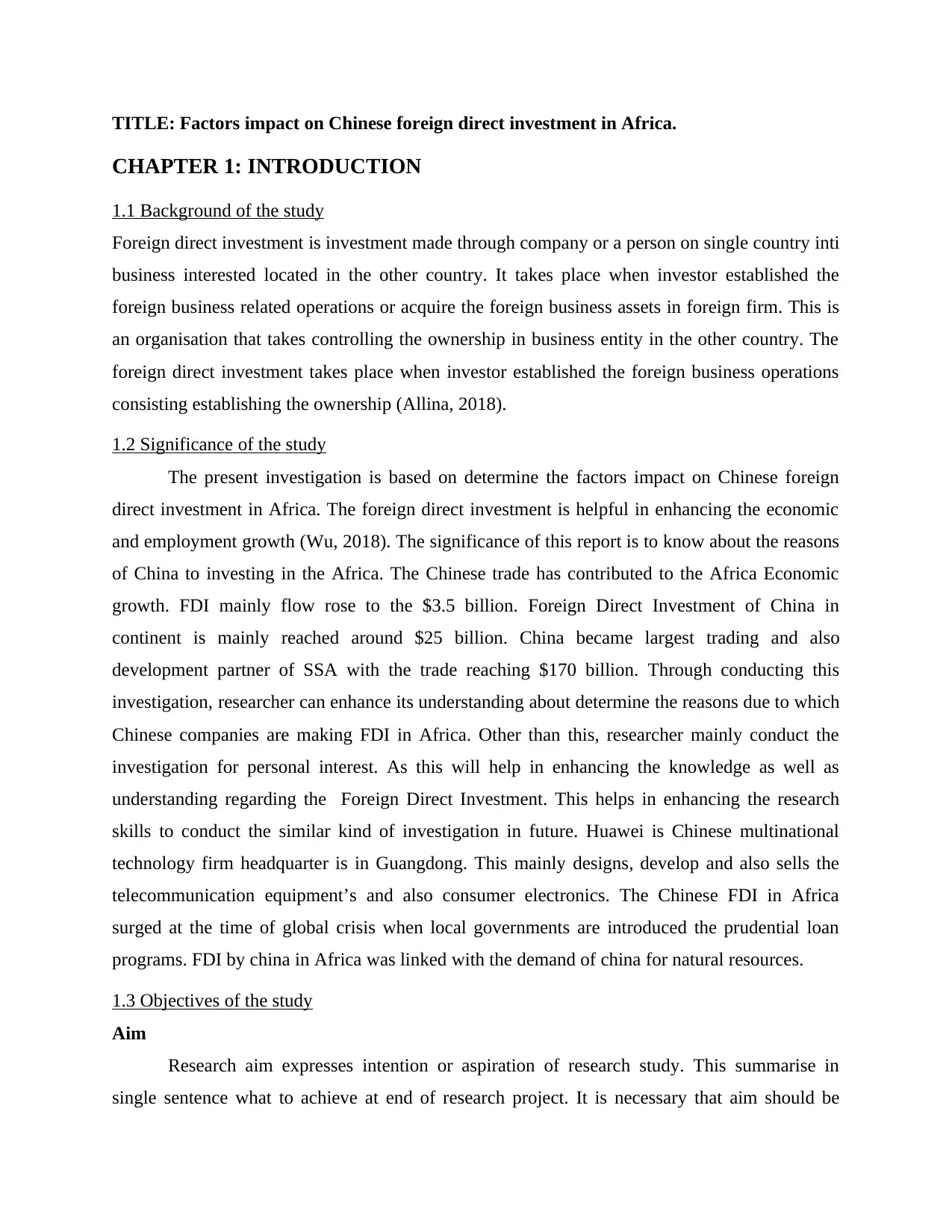
TITLE: Factors impact on Chinese foreign direct investment in Africa.
CHAPTER 1: INTRODUCTION
1.1 Background of the study
Foreign direct investment is investment made through company or a person on single country inti
business interested located in the other country. It takes place when investor established the
foreign business related operations or acquire the foreign business assets in foreign firm. This is
an organisation that takes controlling the ownership in business entity in the other country. The
foreign direct investment takes place when investor established the foreign business operations
consisting establishing the ownership (Allina, 2018).
1.2 Significance of the study
The present investigation is based on determine the factors impact on Chinese foreign
direct investment in Africa. The foreign direct investment is helpful in enhancing the economic
and employment growth (Wu, 2018). The significance of this report is to know about the reasons
of China to investing in the Africa. The Chinese trade has contributed to the Africa Economic
growth. FDI mainly flow rose to the $3.5 billion. Foreign Direct Investment of China in
continent is mainly reached around $25 billion. China became largest trading and also
development partner of SSA with the trade reaching $170 billion. Through conducting this
investigation, researcher can enhance its understanding about determine the reasons due to which
Chinese companies are making FDI in Africa. Other than this, researcher mainly conduct the
investigation for personal interest. As this will help in enhancing the knowledge as well as
understanding regarding the Foreign Direct Investment. This helps in enhancing the research
skills to conduct the similar kind of investigation in future. Huawei is Chinese multinational
technology firm headquarter is in Guangdong. This mainly designs, develop and also sells the
telecommunication equipment’s and also consumer electronics. The Chinese FDI in Africa
surged at the time of global crisis when local governments are introduced the prudential loan
programs. FDI by china in Africa was linked with the demand of china for natural resources.
1.3 Objectives of the study
Aim
Research aim expresses intention or aspiration of research study. This summarise in
single sentence what to achieve at end of research project. It is necessary that aim should be
CHAPTER 1: INTRODUCTION
1.1 Background of the study
Foreign direct investment is investment made through company or a person on single country inti
business interested located in the other country. It takes place when investor established the
foreign business related operations or acquire the foreign business assets in foreign firm. This is
an organisation that takes controlling the ownership in business entity in the other country. The
foreign direct investment takes place when investor established the foreign business operations
consisting establishing the ownership (Allina, 2018).
1.2 Significance of the study
The present investigation is based on determine the factors impact on Chinese foreign
direct investment in Africa. The foreign direct investment is helpful in enhancing the economic
and employment growth (Wu, 2018). The significance of this report is to know about the reasons
of China to investing in the Africa. The Chinese trade has contributed to the Africa Economic
growth. FDI mainly flow rose to the $3.5 billion. Foreign Direct Investment of China in
continent is mainly reached around $25 billion. China became largest trading and also
development partner of SSA with the trade reaching $170 billion. Through conducting this
investigation, researcher can enhance its understanding about determine the reasons due to which
Chinese companies are making FDI in Africa. Other than this, researcher mainly conduct the
investigation for personal interest. As this will help in enhancing the knowledge as well as
understanding regarding the Foreign Direct Investment. This helps in enhancing the research
skills to conduct the similar kind of investigation in future. Huawei is Chinese multinational
technology firm headquarter is in Guangdong. This mainly designs, develop and also sells the
telecommunication equipment’s and also consumer electronics. The Chinese FDI in Africa
surged at the time of global crisis when local governments are introduced the prudential loan
programs. FDI by china in Africa was linked with the demand of china for natural resources.
1.3 Objectives of the study
Aim
Research aim expresses intention or aspiration of research study. This summarise in
single sentence what to achieve at end of research project. It is necessary that aim should be
⊘ This is a preview!⊘
Do you want full access?
Subscribe today to unlock all pages.

Trusted by 1+ million students worldwide
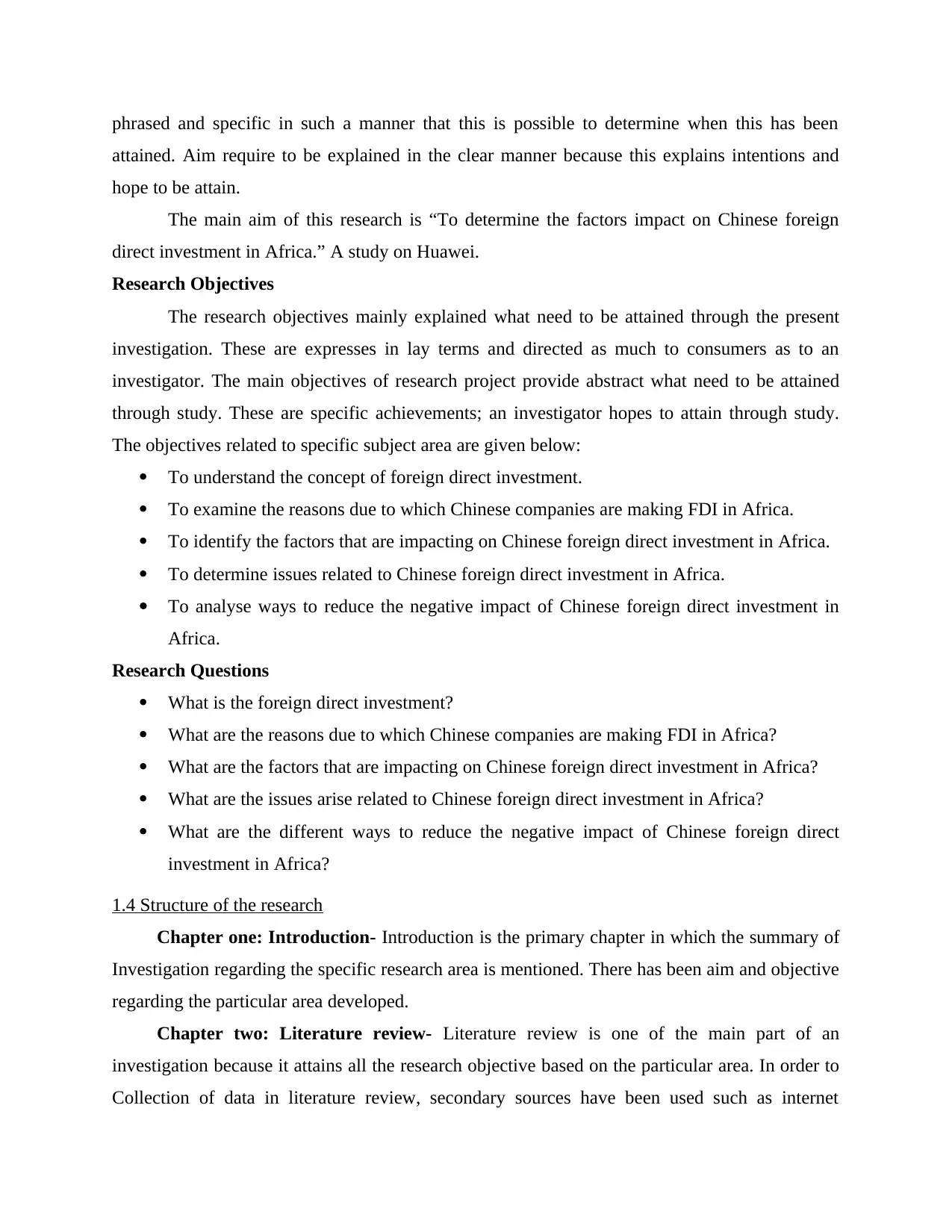
phrased and specific in such a manner that this is possible to determine when this has been
attained. Aim require to be explained in the clear manner because this explains intentions and
hope to be attain.
The main aim of this research is “To determine the factors impact on Chinese foreign
direct investment in Africa.” A study on Huawei.
Research Objectives
The research objectives mainly explained what need to be attained through the present
investigation. These are expresses in lay terms and directed as much to consumers as to an
investigator. The main objectives of research project provide abstract what need to be attained
through study. These are specific achievements; an investigator hopes to attain through study.
The objectives related to specific subject area are given below:
To understand the concept of foreign direct investment.
To examine the reasons due to which Chinese companies are making FDI in Africa.
To identify the factors that are impacting on Chinese foreign direct investment in Africa.
To determine issues related to Chinese foreign direct investment in Africa.
To analyse ways to reduce the negative impact of Chinese foreign direct investment in
Africa.
Research Questions
What is the foreign direct investment?
What are the reasons due to which Chinese companies are making FDI in Africa?
What are the factors that are impacting on Chinese foreign direct investment in Africa?
What are the issues arise related to Chinese foreign direct investment in Africa?
What are the different ways to reduce the negative impact of Chinese foreign direct
investment in Africa?
1.4 Structure of the research
Chapter one: Introduction- Introduction is the primary chapter in which the summary of
Investigation regarding the specific research area is mentioned. There has been aim and objective
regarding the particular area developed.
Chapter two: Literature review- Literature review is one of the main part of an
investigation because it attains all the research objective based on the particular area. In order to
Collection of data in literature review, secondary sources have been used such as internet
attained. Aim require to be explained in the clear manner because this explains intentions and
hope to be attain.
The main aim of this research is “To determine the factors impact on Chinese foreign
direct investment in Africa.” A study on Huawei.
Research Objectives
The research objectives mainly explained what need to be attained through the present
investigation. These are expresses in lay terms and directed as much to consumers as to an
investigator. The main objectives of research project provide abstract what need to be attained
through study. These are specific achievements; an investigator hopes to attain through study.
The objectives related to specific subject area are given below:
To understand the concept of foreign direct investment.
To examine the reasons due to which Chinese companies are making FDI in Africa.
To identify the factors that are impacting on Chinese foreign direct investment in Africa.
To determine issues related to Chinese foreign direct investment in Africa.
To analyse ways to reduce the negative impact of Chinese foreign direct investment in
Africa.
Research Questions
What is the foreign direct investment?
What are the reasons due to which Chinese companies are making FDI in Africa?
What are the factors that are impacting on Chinese foreign direct investment in Africa?
What are the issues arise related to Chinese foreign direct investment in Africa?
What are the different ways to reduce the negative impact of Chinese foreign direct
investment in Africa?
1.4 Structure of the research
Chapter one: Introduction- Introduction is the primary chapter in which the summary of
Investigation regarding the specific research area is mentioned. There has been aim and objective
regarding the particular area developed.
Chapter two: Literature review- Literature review is one of the main part of an
investigation because it attains all the research objective based on the particular area. In order to
Collection of data in literature review, secondary sources have been used such as internet
Paraphrase This Document
Need a fresh take? Get an instant paraphrase of this document with our AI Paraphraser
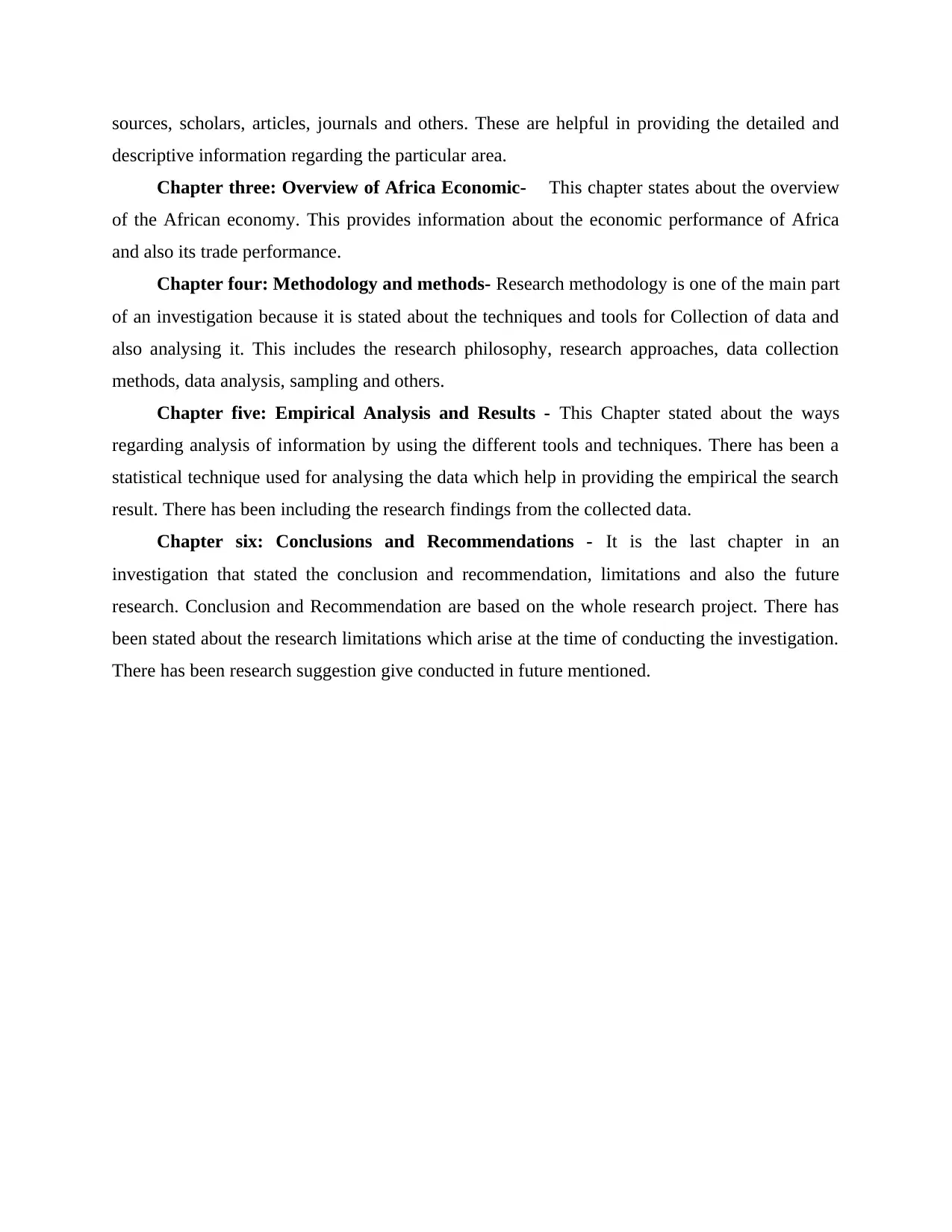
sources, scholars, articles, journals and others. These are helpful in providing the detailed and
descriptive information regarding the particular area.
Chapter three: Overview of Africa Economic- This chapter states about the overview
of the African economy. This provides information about the economic performance of Africa
and also its trade performance.
Chapter four: Methodology and methods- Research methodology is one of the main part
of an investigation because it is stated about the techniques and tools for Collection of data and
also analysing it. This includes the research philosophy, research approaches, data collection
methods, data analysis, sampling and others.
Chapter five: Empirical Analysis and Results - This Chapter stated about the ways
regarding analysis of information by using the different tools and techniques. There has been a
statistical technique used for analysing the data which help in providing the empirical the search
result. There has been including the research findings from the collected data.
Chapter six: Conclusions and Recommendations - It is the last chapter in an
investigation that stated the conclusion and recommendation, limitations and also the future
research. Conclusion and Recommendation are based on the whole research project. There has
been stated about the research limitations which arise at the time of conducting the investigation.
There has been research suggestion give conducted in future mentioned.
descriptive information regarding the particular area.
Chapter three: Overview of Africa Economic- This chapter states about the overview
of the African economy. This provides information about the economic performance of Africa
and also its trade performance.
Chapter four: Methodology and methods- Research methodology is one of the main part
of an investigation because it is stated about the techniques and tools for Collection of data and
also analysing it. This includes the research philosophy, research approaches, data collection
methods, data analysis, sampling and others.
Chapter five: Empirical Analysis and Results - This Chapter stated about the ways
regarding analysis of information by using the different tools and techniques. There has been a
statistical technique used for analysing the data which help in providing the empirical the search
result. There has been including the research findings from the collected data.
Chapter six: Conclusions and Recommendations - It is the last chapter in an
investigation that stated the conclusion and recommendation, limitations and also the future
research. Conclusion and Recommendation are based on the whole research project. There has
been stated about the research limitations which arise at the time of conducting the investigation.
There has been research suggestion give conducted in future mentioned.
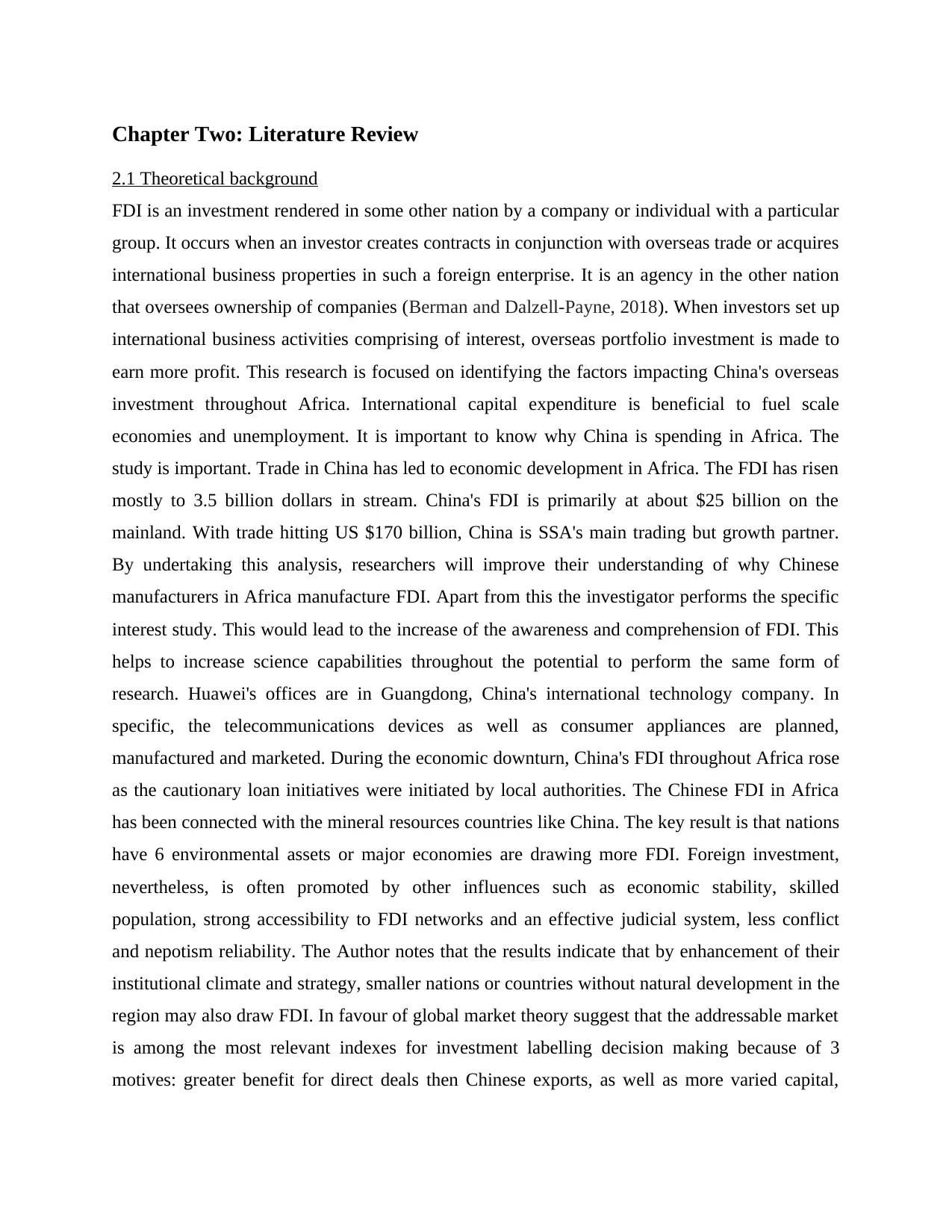
Chapter Two: Literature Review
2.1 Theoretical background
FDI is an investment rendered in some other nation by a company or individual with a particular
group. It occurs when an investor creates contracts in conjunction with overseas trade or acquires
international business properties in such a foreign enterprise. It is an agency in the other nation
that oversees ownership of companies (Berman and Dalzell-Payne, 2018). When investors set up
international business activities comprising of interest, overseas portfolio investment is made to
earn more profit. This research is focused on identifying the factors impacting China's overseas
investment throughout Africa. International capital expenditure is beneficial to fuel scale
economies and unemployment. It is important to know why China is spending in Africa. The
study is important. Trade in China has led to economic development in Africa. The FDI has risen
mostly to 3.5 billion dollars in stream. China's FDI is primarily at about $25 billion on the
mainland. With trade hitting US $170 billion, China is SSA's main trading but growth partner.
By undertaking this analysis, researchers will improve their understanding of why Chinese
manufacturers in Africa manufacture FDI. Apart from this the investigator performs the specific
interest study. This would lead to the increase of the awareness and comprehension of FDI. This
helps to increase science capabilities throughout the potential to perform the same form of
research. Huawei's offices are in Guangdong, China's international technology company. In
specific, the telecommunications devices as well as consumer appliances are planned,
manufactured and marketed. During the economic downturn, China's FDI throughout Africa rose
as the cautionary loan initiatives were initiated by local authorities. The Chinese FDI in Africa
has been connected with the mineral resources countries like China. The key result is that nations
have 6 environmental assets or major economies are drawing more FDI. Foreign investment,
nevertheless, is often promoted by other influences such as economic stability, skilled
population, strong accessibility to FDI networks and an effective judicial system, less conflict
and nepotism reliability. The Author notes that the results indicate that by enhancement of their
institutional climate and strategy, smaller nations or countries without natural development in the
region may also draw FDI. In favour of global market theory suggest that the addressable market
is among the most relevant indexes for investment labelling decision making because of 3
motives: greater benefit for direct deals then Chinese exports, as well as more varied capital,
2.1 Theoretical background
FDI is an investment rendered in some other nation by a company or individual with a particular
group. It occurs when an investor creates contracts in conjunction with overseas trade or acquires
international business properties in such a foreign enterprise. It is an agency in the other nation
that oversees ownership of companies (Berman and Dalzell-Payne, 2018). When investors set up
international business activities comprising of interest, overseas portfolio investment is made to
earn more profit. This research is focused on identifying the factors impacting China's overseas
investment throughout Africa. International capital expenditure is beneficial to fuel scale
economies and unemployment. It is important to know why China is spending in Africa. The
study is important. Trade in China has led to economic development in Africa. The FDI has risen
mostly to 3.5 billion dollars in stream. China's FDI is primarily at about $25 billion on the
mainland. With trade hitting US $170 billion, China is SSA's main trading but growth partner.
By undertaking this analysis, researchers will improve their understanding of why Chinese
manufacturers in Africa manufacture FDI. Apart from this the investigator performs the specific
interest study. This would lead to the increase of the awareness and comprehension of FDI. This
helps to increase science capabilities throughout the potential to perform the same form of
research. Huawei's offices are in Guangdong, China's international technology company. In
specific, the telecommunications devices as well as consumer appliances are planned,
manufactured and marketed. During the economic downturn, China's FDI throughout Africa rose
as the cautionary loan initiatives were initiated by local authorities. The Chinese FDI in Africa
has been connected with the mineral resources countries like China. The key result is that nations
have 6 environmental assets or major economies are drawing more FDI. Foreign investment,
nevertheless, is often promoted by other influences such as economic stability, skilled
population, strong accessibility to FDI networks and an effective judicial system, less conflict
and nepotism reliability. The Author notes that the results indicate that by enhancement of their
institutional climate and strategy, smaller nations or countries without natural development in the
region may also draw FDI. In favour of global market theory suggest that the addressable market
is among the most relevant indexes for investment labelling decision making because of 3
motives: greater benefit for direct deals then Chinese exports, as well as more varied capital,
⊘ This is a preview!⊘
Do you want full access?
Subscribe today to unlock all pages.

Trusted by 1+ million students worldwide
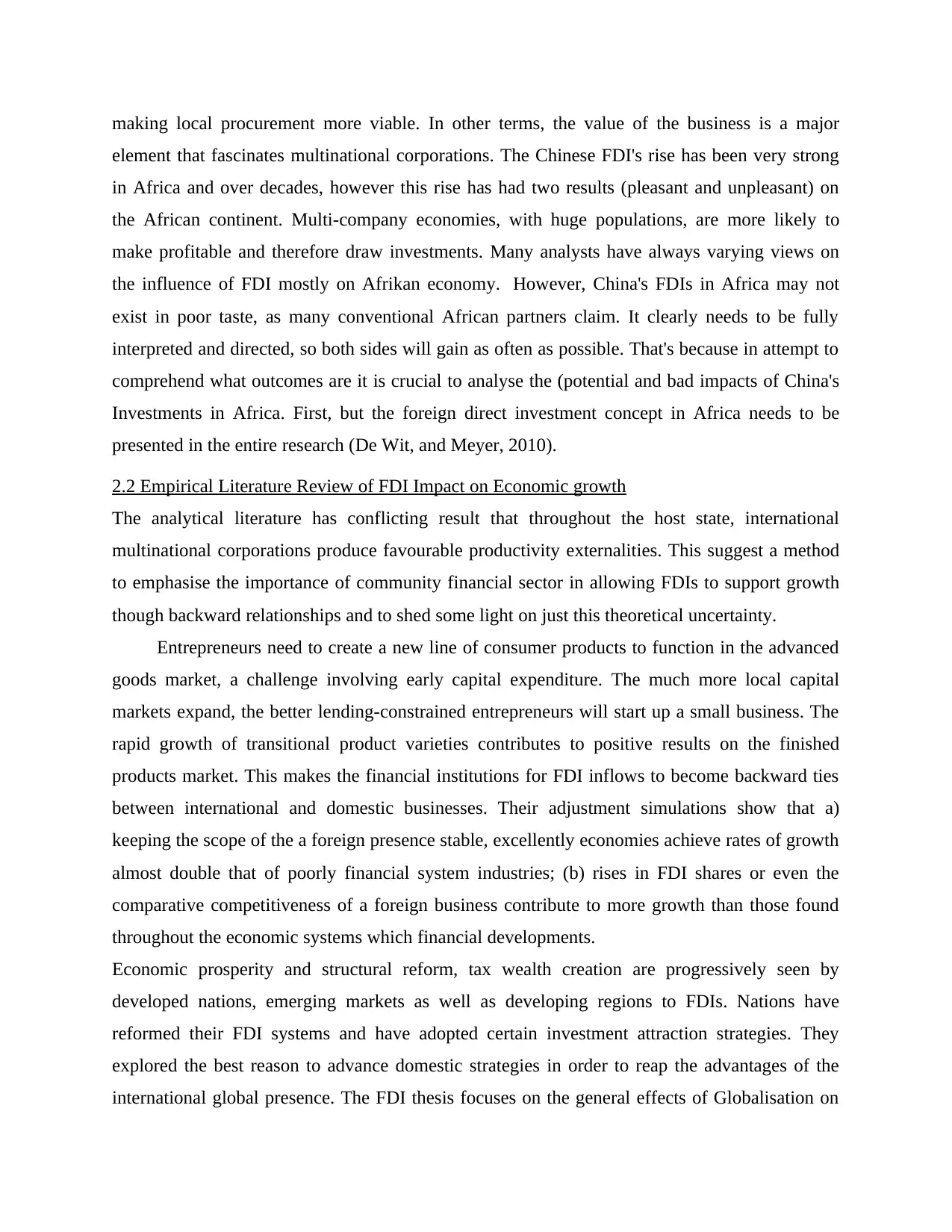
making local procurement more viable. In other terms, the value of the business is a major
element that fascinates multinational corporations. The Chinese FDI's rise has been very strong
in Africa and over decades, however this rise has had two results (pleasant and unpleasant) on
the African continent. Multi-company economies, with huge populations, are more likely to
make profitable and therefore draw investments. Many analysts have always varying views on
the influence of FDI mostly on Afrikan economy. However, China's FDIs in Africa may not
exist in poor taste, as many conventional African partners claim. It clearly needs to be fully
interpreted and directed, so both sides will gain as often as possible. That's because in attempt to
comprehend what outcomes are it is crucial to analyse the (potential and bad impacts of China's
Investments in Africa. First, but the foreign direct investment concept in Africa needs to be
presented in the entire research (De Wit, and Meyer, 2010).
2.2 Empirical Literature Review of FDI Impact on Economic growth
The analytical literature has conflicting result that throughout the host state, international
multinational corporations produce favourable productivity externalities. This suggest a method
to emphasise the importance of community financial sector in allowing FDIs to support growth
though backward relationships and to shed some light on just this theoretical uncertainty.
Entrepreneurs need to create a new line of consumer products to function in the advanced
goods market, a challenge involving early capital expenditure. The much more local capital
markets expand, the better lending-constrained entrepreneurs will start up a small business. The
rapid growth of transitional product varieties contributes to positive results on the finished
products market. This makes the financial institutions for FDI inflows to become backward ties
between international and domestic businesses. Their adjustment simulations show that a)
keeping the scope of the a foreign presence stable, excellently economies achieve rates of growth
almost double that of poorly financial system industries; (b) rises in FDI shares or even the
comparative competitiveness of a foreign business contribute to more growth than those found
throughout the economic systems which financial developments.
Economic prosperity and structural reform, tax wealth creation are progressively seen by
developed nations, emerging markets as well as developing regions to FDIs. Nations have
reformed their FDI systems and have adopted certain investment attraction strategies. They
explored the best reason to advance domestic strategies in order to reap the advantages of the
international global presence. The FDI thesis focuses on the general effects of Globalisation on
element that fascinates multinational corporations. The Chinese FDI's rise has been very strong
in Africa and over decades, however this rise has had two results (pleasant and unpleasant) on
the African continent. Multi-company economies, with huge populations, are more likely to
make profitable and therefore draw investments. Many analysts have always varying views on
the influence of FDI mostly on Afrikan economy. However, China's FDIs in Africa may not
exist in poor taste, as many conventional African partners claim. It clearly needs to be fully
interpreted and directed, so both sides will gain as often as possible. That's because in attempt to
comprehend what outcomes are it is crucial to analyse the (potential and bad impacts of China's
Investments in Africa. First, but the foreign direct investment concept in Africa needs to be
presented in the entire research (De Wit, and Meyer, 2010).
2.2 Empirical Literature Review of FDI Impact on Economic growth
The analytical literature has conflicting result that throughout the host state, international
multinational corporations produce favourable productivity externalities. This suggest a method
to emphasise the importance of community financial sector in allowing FDIs to support growth
though backward relationships and to shed some light on just this theoretical uncertainty.
Entrepreneurs need to create a new line of consumer products to function in the advanced
goods market, a challenge involving early capital expenditure. The much more local capital
markets expand, the better lending-constrained entrepreneurs will start up a small business. The
rapid growth of transitional product varieties contributes to positive results on the finished
products market. This makes the financial institutions for FDI inflows to become backward ties
between international and domestic businesses. Their adjustment simulations show that a)
keeping the scope of the a foreign presence stable, excellently economies achieve rates of growth
almost double that of poorly financial system industries; (b) rises in FDI shares or even the
comparative competitiveness of a foreign business contribute to more growth than those found
throughout the economic systems which financial developments.
Economic prosperity and structural reform, tax wealth creation are progressively seen by
developed nations, emerging markets as well as developing regions to FDIs. Nations have
reformed their FDI systems and have adopted certain investment attraction strategies. They
explored the best reason to advance domestic strategies in order to reap the advantages of the
international global presence. The FDI thesis focuses on the general effects of Globalisation on
Paraphrase This Document
Need a fresh take? Get an instant paraphrase of this document with our AI Paraphraser
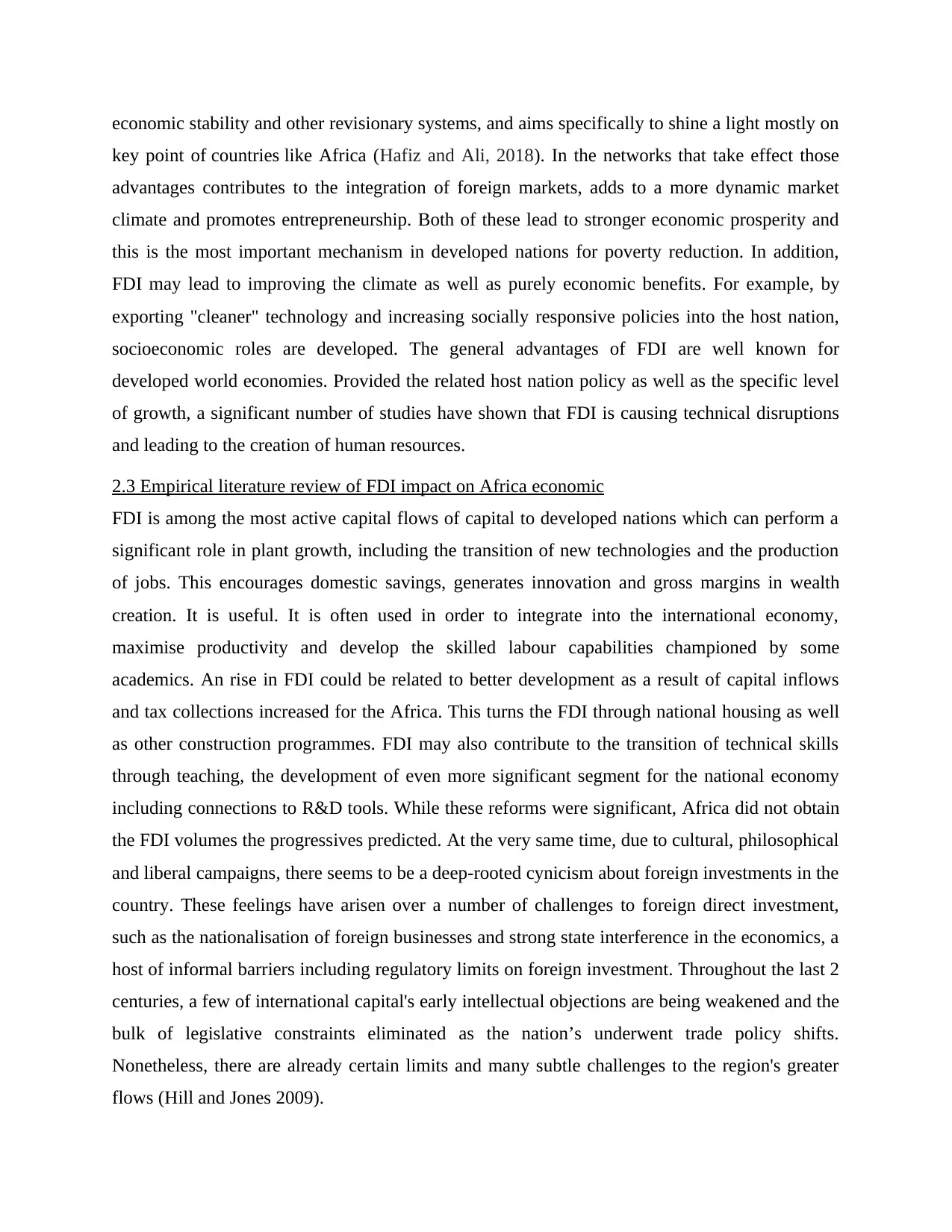
economic stability and other revisionary systems, and aims specifically to shine a light mostly on
key point of countries like Africa (Hafiz and Ali, 2018). In the networks that take effect those
advantages contributes to the integration of foreign markets, adds to a more dynamic market
climate and promotes entrepreneurship. Both of these lead to stronger economic prosperity and
this is the most important mechanism in developed nations for poverty reduction. In addition,
FDI may lead to improving the climate as well as purely economic benefits. For example, by
exporting "cleaner" technology and increasing socially responsive policies into the host nation,
socioeconomic roles are developed. The general advantages of FDI are well known for
developed world economies. Provided the related host nation policy as well as the specific level
of growth, a significant number of studies have shown that FDI is causing technical disruptions
and leading to the creation of human resources.
2.3 Empirical literature review of FDI impact on Africa economic
FDI is among the most active capital flows of capital to developed nations which can perform a
significant role in plant growth, including the transition of new technologies and the production
of jobs. This encourages domestic savings, generates innovation and gross margins in wealth
creation. It is useful. It is often used in order to integrate into the international economy,
maximise productivity and develop the skilled labour capabilities championed by some
academics. An rise in FDI could be related to better development as a result of capital inflows
and tax collections increased for the Africa. This turns the FDI through national housing as well
as other construction programmes. FDI may also contribute to the transition of technical skills
through teaching, the development of even more significant segment for the national economy
including connections to R&D tools. While these reforms were significant, Africa did not obtain
the FDI volumes the progressives predicted. At the very same time, due to cultural, philosophical
and liberal campaigns, there seems to be a deep-rooted cynicism about foreign investments in the
country. These feelings have arisen over a number of challenges to foreign direct investment,
such as the nationalisation of foreign businesses and strong state interference in the economics, a
host of informal barriers including regulatory limits on foreign investment. Throughout the last 2
centuries, a few of international capital's early intellectual objections are being weakened and the
bulk of legislative constraints eliminated as the nation’s underwent trade policy shifts.
Nonetheless, there are already certain limits and many subtle challenges to the region's greater
flows (Hill and Jones 2009).
key point of countries like Africa (Hafiz and Ali, 2018). In the networks that take effect those
advantages contributes to the integration of foreign markets, adds to a more dynamic market
climate and promotes entrepreneurship. Both of these lead to stronger economic prosperity and
this is the most important mechanism in developed nations for poverty reduction. In addition,
FDI may lead to improving the climate as well as purely economic benefits. For example, by
exporting "cleaner" technology and increasing socially responsive policies into the host nation,
socioeconomic roles are developed. The general advantages of FDI are well known for
developed world economies. Provided the related host nation policy as well as the specific level
of growth, a significant number of studies have shown that FDI is causing technical disruptions
and leading to the creation of human resources.
2.3 Empirical literature review of FDI impact on Africa economic
FDI is among the most active capital flows of capital to developed nations which can perform a
significant role in plant growth, including the transition of new technologies and the production
of jobs. This encourages domestic savings, generates innovation and gross margins in wealth
creation. It is useful. It is often used in order to integrate into the international economy,
maximise productivity and develop the skilled labour capabilities championed by some
academics. An rise in FDI could be related to better development as a result of capital inflows
and tax collections increased for the Africa. This turns the FDI through national housing as well
as other construction programmes. FDI may also contribute to the transition of technical skills
through teaching, the development of even more significant segment for the national economy
including connections to R&D tools. While these reforms were significant, Africa did not obtain
the FDI volumes the progressives predicted. At the very same time, due to cultural, philosophical
and liberal campaigns, there seems to be a deep-rooted cynicism about foreign investments in the
country. These feelings have arisen over a number of challenges to foreign direct investment,
such as the nationalisation of foreign businesses and strong state interference in the economics, a
host of informal barriers including regulatory limits on foreign investment. Throughout the last 2
centuries, a few of international capital's early intellectual objections are being weakened and the
bulk of legislative constraints eliminated as the nation’s underwent trade policy shifts.
Nonetheless, there are already certain limits and many subtle challenges to the region's greater
flows (Hill and Jones 2009).
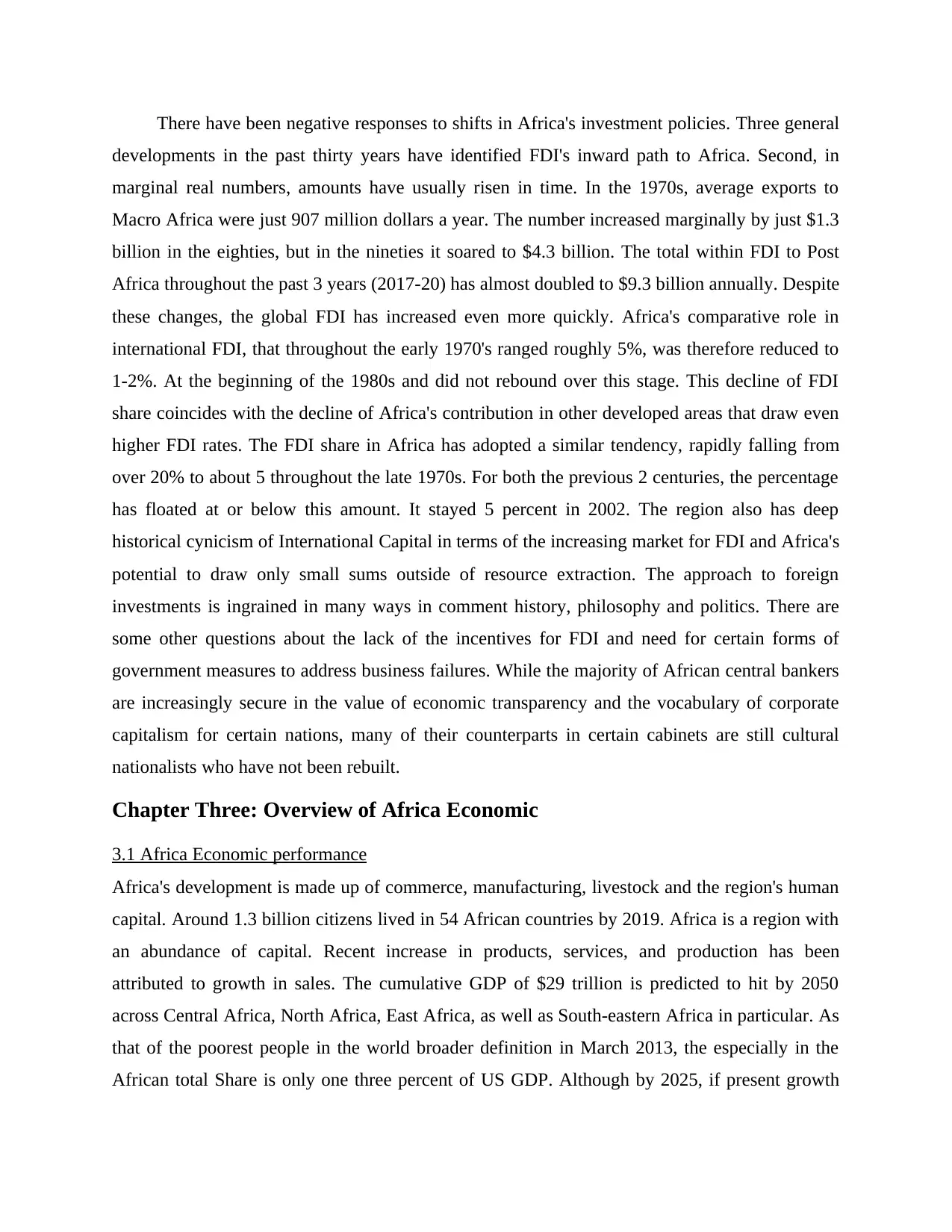
There have been negative responses to shifts in Africa's investment policies. Three general
developments in the past thirty years have identified FDI's inward path to Africa. Second, in
marginal real numbers, amounts have usually risen in time. In the 1970s, average exports to
Macro Africa were just 907 million dollars a year. The number increased marginally by just $1.3
billion in the eighties, but in the nineties it soared to $4.3 billion. The total within FDI to Post
Africa throughout the past 3 years (2017-20) has almost doubled to $9.3 billion annually. Despite
these changes, the global FDI has increased even more quickly. Africa's comparative role in
international FDI, that throughout the early 1970's ranged roughly 5%, was therefore reduced to
1-2%. At the beginning of the 1980s and did not rebound over this stage. This decline of FDI
share coincides with the decline of Africa's contribution in other developed areas that draw even
higher FDI rates. The FDI share in Africa has adopted a similar tendency, rapidly falling from
over 20% to about 5 throughout the late 1970s. For both the previous 2 centuries, the percentage
has floated at or below this amount. It stayed 5 percent in 2002. The region also has deep
historical cynicism of International Capital in terms of the increasing market for FDI and Africa's
potential to draw only small sums outside of resource extraction. The approach to foreign
investments is ingrained in many ways in comment history, philosophy and politics. There are
some other questions about the lack of the incentives for FDI and need for certain forms of
government measures to address business failures. While the majority of African central bankers
are increasingly secure in the value of economic transparency and the vocabulary of corporate
capitalism for certain nations, many of their counterparts in certain cabinets are still cultural
nationalists who have not been rebuilt.
Chapter Three: Overview of Africa Economic
3.1 Africa Economic performance
Africa's development is made up of commerce, manufacturing, livestock and the region's human
capital. Around 1.3 billion citizens lived in 54 African countries by 2019. Africa is a region with
an abundance of capital. Recent increase in products, services, and production has been
attributed to growth in sales. The cumulative GDP of $29 trillion is predicted to hit by 2050
across Central Africa, North Africa, East Africa, as well as South-eastern Africa in particular. As
that of the poorest people in the world broader definition in March 2013, the especially in the
African total Share is only one three percent of US GDP. Although by 2025, if present growth
developments in the past thirty years have identified FDI's inward path to Africa. Second, in
marginal real numbers, amounts have usually risen in time. In the 1970s, average exports to
Macro Africa were just 907 million dollars a year. The number increased marginally by just $1.3
billion in the eighties, but in the nineties it soared to $4.3 billion. The total within FDI to Post
Africa throughout the past 3 years (2017-20) has almost doubled to $9.3 billion annually. Despite
these changes, the global FDI has increased even more quickly. Africa's comparative role in
international FDI, that throughout the early 1970's ranged roughly 5%, was therefore reduced to
1-2%. At the beginning of the 1980s and did not rebound over this stage. This decline of FDI
share coincides with the decline of Africa's contribution in other developed areas that draw even
higher FDI rates. The FDI share in Africa has adopted a similar tendency, rapidly falling from
over 20% to about 5 throughout the late 1970s. For both the previous 2 centuries, the percentage
has floated at or below this amount. It stayed 5 percent in 2002. The region also has deep
historical cynicism of International Capital in terms of the increasing market for FDI and Africa's
potential to draw only small sums outside of resource extraction. The approach to foreign
investments is ingrained in many ways in comment history, philosophy and politics. There are
some other questions about the lack of the incentives for FDI and need for certain forms of
government measures to address business failures. While the majority of African central bankers
are increasingly secure in the value of economic transparency and the vocabulary of corporate
capitalism for certain nations, many of their counterparts in certain cabinets are still cultural
nationalists who have not been rebuilt.
Chapter Three: Overview of Africa Economic
3.1 Africa Economic performance
Africa's development is made up of commerce, manufacturing, livestock and the region's human
capital. Around 1.3 billion citizens lived in 54 African countries by 2019. Africa is a region with
an abundance of capital. Recent increase in products, services, and production has been
attributed to growth in sales. The cumulative GDP of $29 trillion is predicted to hit by 2050
across Central Africa, North Africa, East Africa, as well as South-eastern Africa in particular. As
that of the poorest people in the world broader definition in March 2013, the especially in the
African total Share is only one three percent of US GDP. Although by 2025, if present growth
⊘ This is a preview!⊘
Do you want full access?
Subscribe today to unlock all pages.

Trusted by 1+ million students worldwide
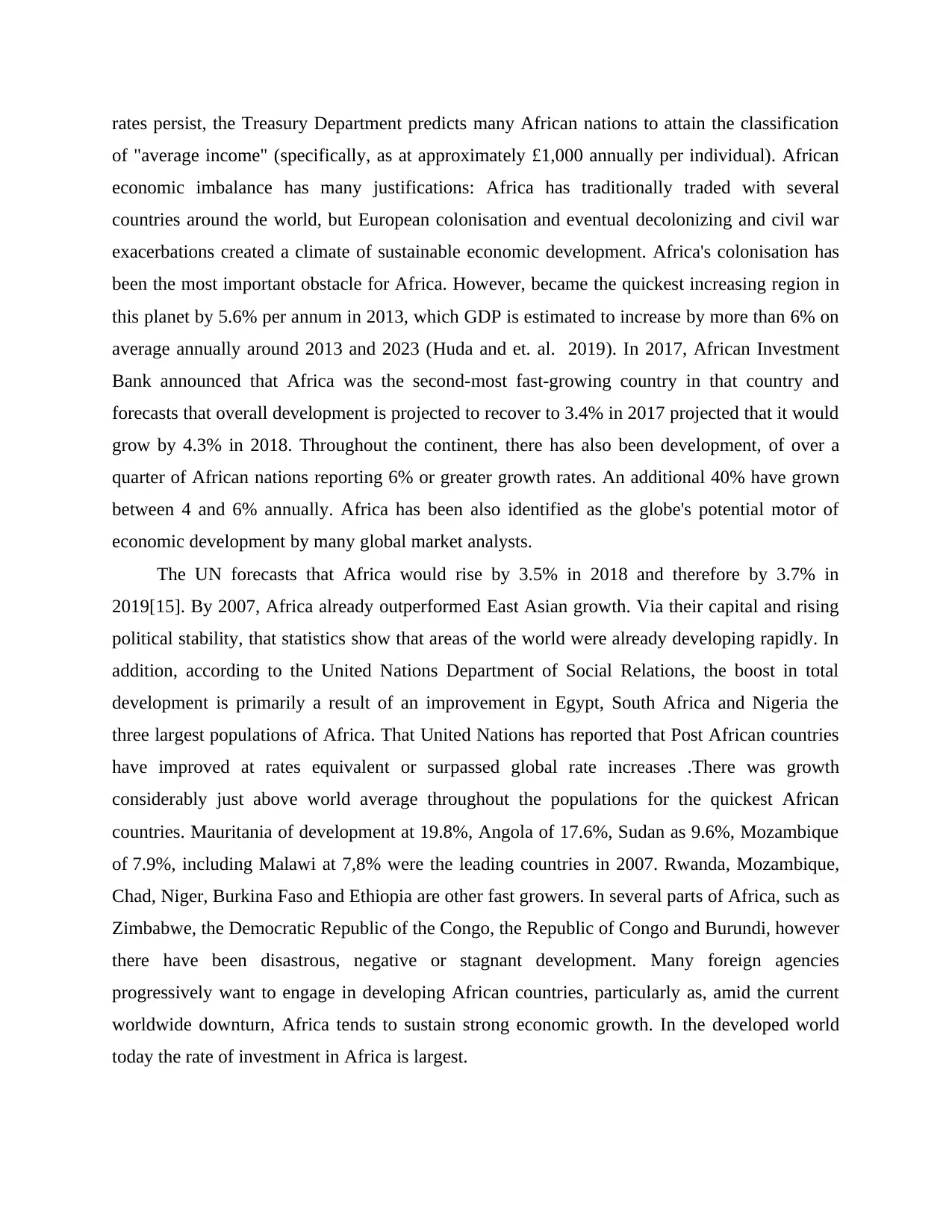
rates persist, the Treasury Department predicts many African nations to attain the classification
of "average income" (specifically, as at approximately £1,000 annually per individual). African
economic imbalance has many justifications: Africa has traditionally traded with several
countries around the world, but European colonisation and eventual decolonizing and civil war
exacerbations created a climate of sustainable economic development. Africa's colonisation has
been the most important obstacle for Africa. However, became the quickest increasing region in
this planet by 5.6% per annum in 2013, which GDP is estimated to increase by more than 6% on
average annually around 2013 and 2023 (Huda and et. al. 2019). In 2017, African Investment
Bank announced that Africa was the second-most fast-growing country in that country and
forecasts that overall development is projected to recover to 3.4% in 2017 projected that it would
grow by 4.3% in 2018. Throughout the continent, there has also been development, of over a
quarter of African nations reporting 6% or greater growth rates. An additional 40% have grown
between 4 and 6% annually. Africa has been also identified as the globe's potential motor of
economic development by many global market analysts.
The UN forecasts that Africa would rise by 3.5% in 2018 and therefore by 3.7% in
2019[15]. By 2007, Africa already outperformed East Asian growth. Via their capital and rising
political stability, that statistics show that areas of the world were already developing rapidly. In
addition, according to the United Nations Department of Social Relations, the boost in total
development is primarily a result of an improvement in Egypt, South Africa and Nigeria the
three largest populations of Africa. That United Nations has reported that Post African countries
have improved at rates equivalent or surpassed global rate increases .There was growth
considerably just above world average throughout the populations for the quickest African
countries. Mauritania of development at 19.8%, Angola of 17.6%, Sudan as 9.6%, Mozambique
of 7.9%, including Malawi at 7,8% were the leading countries in 2007. Rwanda, Mozambique,
Chad, Niger, Burkina Faso and Ethiopia are other fast growers. In several parts of Africa, such as
Zimbabwe, the Democratic Republic of the Congo, the Republic of Congo and Burundi, however
there have been disastrous, negative or stagnant development. Many foreign agencies
progressively want to engage in developing African countries, particularly as, amid the current
worldwide downturn, Africa tends to sustain strong economic growth. In the developed world
today the rate of investment in Africa is largest.
of "average income" (specifically, as at approximately £1,000 annually per individual). African
economic imbalance has many justifications: Africa has traditionally traded with several
countries around the world, but European colonisation and eventual decolonizing and civil war
exacerbations created a climate of sustainable economic development. Africa's colonisation has
been the most important obstacle for Africa. However, became the quickest increasing region in
this planet by 5.6% per annum in 2013, which GDP is estimated to increase by more than 6% on
average annually around 2013 and 2023 (Huda and et. al. 2019). In 2017, African Investment
Bank announced that Africa was the second-most fast-growing country in that country and
forecasts that overall development is projected to recover to 3.4% in 2017 projected that it would
grow by 4.3% in 2018. Throughout the continent, there has also been development, of over a
quarter of African nations reporting 6% or greater growth rates. An additional 40% have grown
between 4 and 6% annually. Africa has been also identified as the globe's potential motor of
economic development by many global market analysts.
The UN forecasts that Africa would rise by 3.5% in 2018 and therefore by 3.7% in
2019[15]. By 2007, Africa already outperformed East Asian growth. Via their capital and rising
political stability, that statistics show that areas of the world were already developing rapidly. In
addition, according to the United Nations Department of Social Relations, the boost in total
development is primarily a result of an improvement in Egypt, South Africa and Nigeria the
three largest populations of Africa. That United Nations has reported that Post African countries
have improved at rates equivalent or surpassed global rate increases .There was growth
considerably just above world average throughout the populations for the quickest African
countries. Mauritania of development at 19.8%, Angola of 17.6%, Sudan as 9.6%, Mozambique
of 7.9%, including Malawi at 7,8% were the leading countries in 2007. Rwanda, Mozambique,
Chad, Niger, Burkina Faso and Ethiopia are other fast growers. In several parts of Africa, such as
Zimbabwe, the Democratic Republic of the Congo, the Republic of Congo and Burundi, however
there have been disastrous, negative or stagnant development. Many foreign agencies
progressively want to engage in developing African countries, particularly as, amid the current
worldwide downturn, Africa tends to sustain strong economic growth. In the developed world
today the rate of investment in Africa is largest.
Paraphrase This Document
Need a fresh take? Get an instant paraphrase of this document with our AI Paraphraser
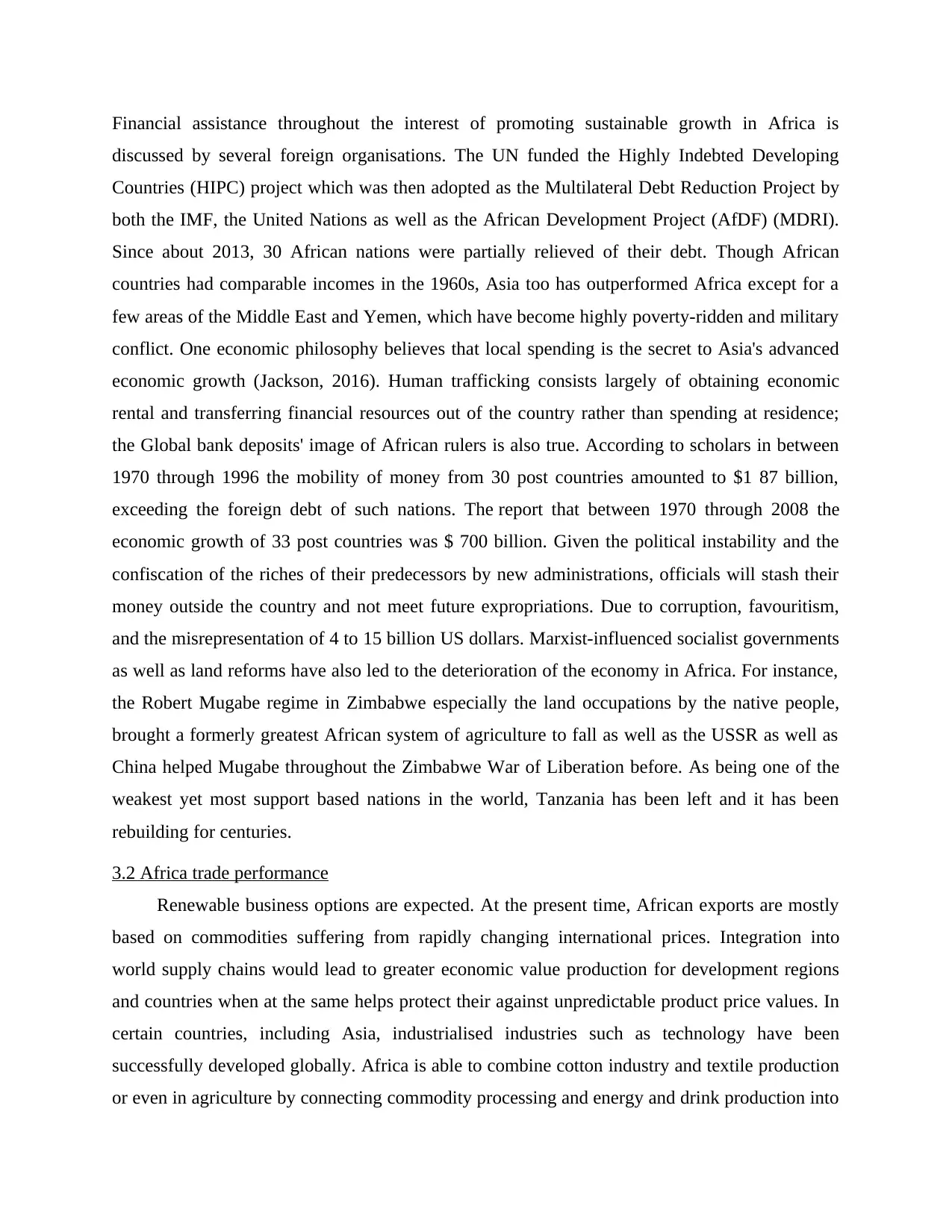
Financial assistance throughout the interest of promoting sustainable growth in Africa is
discussed by several foreign organisations. The UN funded the Highly Indebted Developing
Countries (HIPC) project which was then adopted as the Multilateral Debt Reduction Project by
both the IMF, the United Nations as well as the African Development Project (AfDF) (MDRI).
Since about 2013, 30 African nations were partially relieved of their debt. Though African
countries had comparable incomes in the 1960s, Asia too has outperformed Africa except for a
few areas of the Middle East and Yemen, which have become highly poverty-ridden and military
conflict. One economic philosophy believes that local spending is the secret to Asia's advanced
economic growth (Jackson, 2016). Human trafficking consists largely of obtaining economic
rental and transferring financial resources out of the country rather than spending at residence;
the Global bank deposits' image of African rulers is also true. According to scholars in between
1970 through 1996 the mobility of money from 30 post countries amounted to $1 87 billion,
exceeding the foreign debt of such nations. The report that between 1970 through 2008 the
economic growth of 33 post countries was $ 700 billion. Given the political instability and the
confiscation of the riches of their predecessors by new administrations, officials will stash their
money outside the country and not meet future expropriations. Due to corruption, favouritism,
and the misrepresentation of 4 to 15 billion US dollars. Marxist-influenced socialist governments
as well as land reforms have also led to the deterioration of the economy in Africa. For instance,
the Robert Mugabe regime in Zimbabwe especially the land occupations by the native people,
brought a formerly greatest African system of agriculture to fall as well as the USSR as well as
China helped Mugabe throughout the Zimbabwe War of Liberation before. As being one of the
weakest yet most support based nations in the world, Tanzania has been left and it has been
rebuilding for centuries.
3.2 Africa trade performance
Renewable business options are expected. At the present time, African exports are mostly
based on commodities suffering from rapidly changing international prices. Integration into
world supply chains would lead to greater economic value production for development regions
and countries when at the same helps protect their against unpredictable product price values. In
certain countries, including Asia, industrialised industries such as technology have been
successfully developed globally. Africa is able to combine cotton industry and textile production
or even in agriculture by connecting commodity processing and energy and drink production into
discussed by several foreign organisations. The UN funded the Highly Indebted Developing
Countries (HIPC) project which was then adopted as the Multilateral Debt Reduction Project by
both the IMF, the United Nations as well as the African Development Project (AfDF) (MDRI).
Since about 2013, 30 African nations were partially relieved of their debt. Though African
countries had comparable incomes in the 1960s, Asia too has outperformed Africa except for a
few areas of the Middle East and Yemen, which have become highly poverty-ridden and military
conflict. One economic philosophy believes that local spending is the secret to Asia's advanced
economic growth (Jackson, 2016). Human trafficking consists largely of obtaining economic
rental and transferring financial resources out of the country rather than spending at residence;
the Global bank deposits' image of African rulers is also true. According to scholars in between
1970 through 1996 the mobility of money from 30 post countries amounted to $1 87 billion,
exceeding the foreign debt of such nations. The report that between 1970 through 2008 the
economic growth of 33 post countries was $ 700 billion. Given the political instability and the
confiscation of the riches of their predecessors by new administrations, officials will stash their
money outside the country and not meet future expropriations. Due to corruption, favouritism,
and the misrepresentation of 4 to 15 billion US dollars. Marxist-influenced socialist governments
as well as land reforms have also led to the deterioration of the economy in Africa. For instance,
the Robert Mugabe regime in Zimbabwe especially the land occupations by the native people,
brought a formerly greatest African system of agriculture to fall as well as the USSR as well as
China helped Mugabe throughout the Zimbabwe War of Liberation before. As being one of the
weakest yet most support based nations in the world, Tanzania has been left and it has been
rebuilding for centuries.
3.2 Africa trade performance
Renewable business options are expected. At the present time, African exports are mostly
based on commodities suffering from rapidly changing international prices. Integration into
world supply chains would lead to greater economic value production for development regions
and countries when at the same helps protect their against unpredictable product price values. In
certain countries, including Asia, industrialised industries such as technology have been
successfully developed globally. Africa is able to combine cotton industry and textile production
or even in agriculture by connecting commodity processing and energy and drink production into
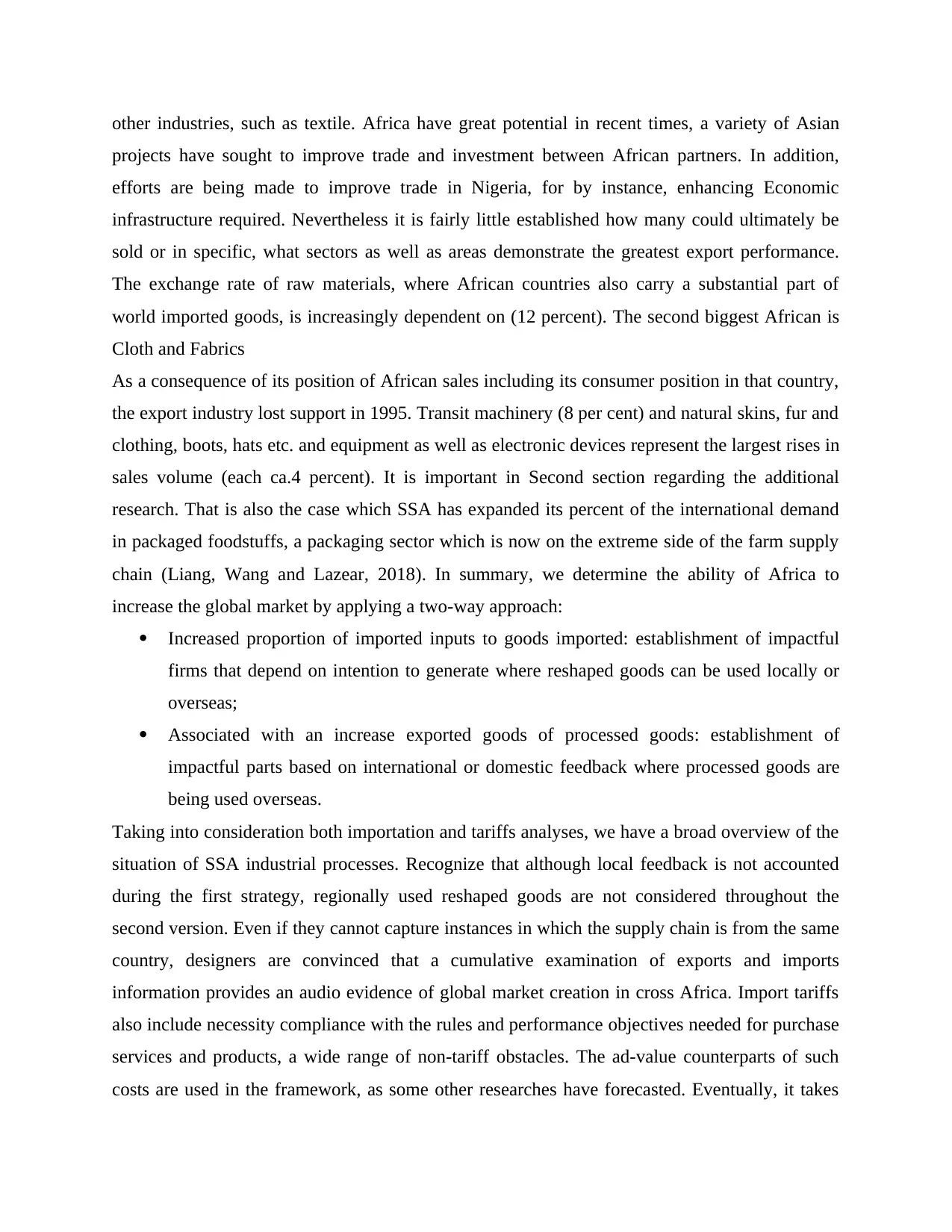
other industries, such as textile. Africa have great potential in recent times, a variety of Asian
projects have sought to improve trade and investment between African partners. In addition,
efforts are being made to improve trade in Nigeria, for by instance, enhancing Economic
infrastructure required. Nevertheless it is fairly little established how many could ultimately be
sold or in specific, what sectors as well as areas demonstrate the greatest export performance.
The exchange rate of raw materials, where African countries also carry a substantial part of
world imported goods, is increasingly dependent on (12 percent). The second biggest African is
Cloth and Fabrics
As a consequence of its position of African sales including its consumer position in that country,
the export industry lost support in 1995. Transit machinery (8 per cent) and natural skins, fur and
clothing, boots, hats etc. and equipment as well as electronic devices represent the largest rises in
sales volume (each ca.4 percent). It is important in Second section regarding the additional
research. That is also the case which SSA has expanded its percent of the international demand
in packaged foodstuffs, a packaging sector which is now on the extreme side of the farm supply
chain (Liang, Wang and Lazear, 2018). In summary, we determine the ability of Africa to
increase the global market by applying a two-way approach:
Increased proportion of imported inputs to goods imported: establishment of impactful
firms that depend on intention to generate where reshaped goods can be used locally or
overseas;
Associated with an increase exported goods of processed goods: establishment of
impactful parts based on international or domestic feedback where processed goods are
being used overseas.
Taking into consideration both importation and tariffs analyses, we have a broad overview of the
situation of SSA industrial processes. Recognize that although local feedback is not accounted
during the first strategy, regionally used reshaped goods are not considered throughout the
second version. Even if they cannot capture instances in which the supply chain is from the same
country, designers are convinced that a cumulative examination of exports and imports
information provides an audio evidence of global market creation in cross Africa. Import tariffs
also include necessity compliance with the rules and performance objectives needed for purchase
services and products, a wide range of non-tariff obstacles. The ad-value counterparts of such
costs are used in the framework, as some other researches have forecasted. Eventually, it takes
projects have sought to improve trade and investment between African partners. In addition,
efforts are being made to improve trade in Nigeria, for by instance, enhancing Economic
infrastructure required. Nevertheless it is fairly little established how many could ultimately be
sold or in specific, what sectors as well as areas demonstrate the greatest export performance.
The exchange rate of raw materials, where African countries also carry a substantial part of
world imported goods, is increasingly dependent on (12 percent). The second biggest African is
Cloth and Fabrics
As a consequence of its position of African sales including its consumer position in that country,
the export industry lost support in 1995. Transit machinery (8 per cent) and natural skins, fur and
clothing, boots, hats etc. and equipment as well as electronic devices represent the largest rises in
sales volume (each ca.4 percent). It is important in Second section regarding the additional
research. That is also the case which SSA has expanded its percent of the international demand
in packaged foodstuffs, a packaging sector which is now on the extreme side of the farm supply
chain (Liang, Wang and Lazear, 2018). In summary, we determine the ability of Africa to
increase the global market by applying a two-way approach:
Increased proportion of imported inputs to goods imported: establishment of impactful
firms that depend on intention to generate where reshaped goods can be used locally or
overseas;
Associated with an increase exported goods of processed goods: establishment of
impactful parts based on international or domestic feedback where processed goods are
being used overseas.
Taking into consideration both importation and tariffs analyses, we have a broad overview of the
situation of SSA industrial processes. Recognize that although local feedback is not accounted
during the first strategy, regionally used reshaped goods are not considered throughout the
second version. Even if they cannot capture instances in which the supply chain is from the same
country, designers are convinced that a cumulative examination of exports and imports
information provides an audio evidence of global market creation in cross Africa. Import tariffs
also include necessity compliance with the rules and performance objectives needed for purchase
services and products, a wide range of non-tariff obstacles. The ad-value counterparts of such
costs are used in the framework, as some other researches have forecasted. Eventually, it takes
⊘ This is a preview!⊘
Do you want full access?
Subscribe today to unlock all pages.

Trusted by 1+ million students worldwide
1 out of 49
Related Documents
Your All-in-One AI-Powered Toolkit for Academic Success.
+13062052269
info@desklib.com
Available 24*7 on WhatsApp / Email
![[object Object]](/_next/static/media/star-bottom.7253800d.svg)
Unlock your academic potential
Copyright © 2020–2025 A2Z Services. All Rights Reserved. Developed and managed by ZUCOL.





